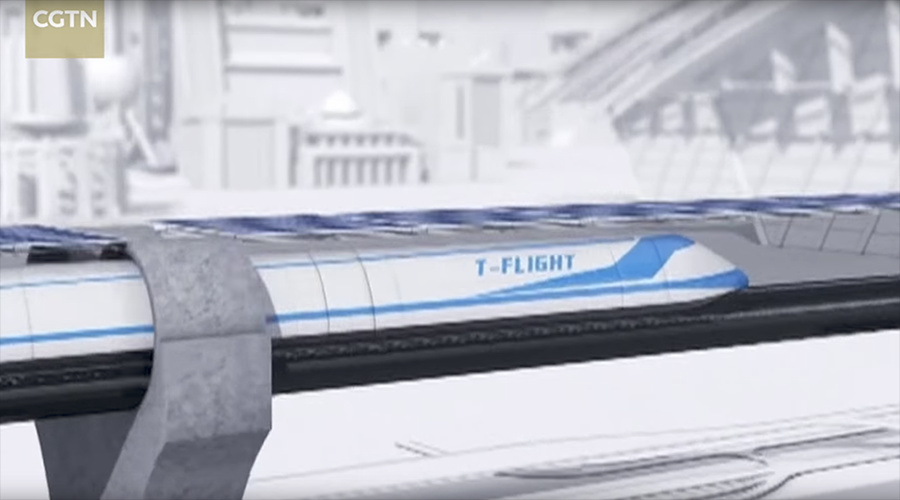By Tom McGregor, CCTV.com Panview commentator and editor
In regards to transportation, China has already enjoyed remarkable success in building and upgrading high-speed rail networks. Passengers can enjoy smooth and comfortable rides at more affordable prices than flying on commercial jets.
But, Chinese scientists are no longer satisfied with just developing trains to go a little bit faster, but dream of developing a HyperFlight Transport with maximum speeds reaching 4,000-km/h.
A team from China Aerospace Science & Technology Industry Corp. (CASIC), who attended the 3rd China (International) Commercial Aerospace Forum in Central China's Wuhan, Hubei Province in Aug. 2017, announced plans to launch a research and development (R&D) project with plans to develop HyperFlight Transport.

Three-dimensional effectiveness diagram of the designed HyperFlight train Photo from CGTN
HyperFlight may emerge as a signature product for China along with the nation's innovations in aerospace, hi-speed trains and nuclear power.
3 stages of supersonic speeds
HyperFlight speeds are ten times faster than hi-speed trains and five times faster than passenger planes.
Mao Kai, technical director of the project, told Xinhua that CASIC "teamed up with more than 20 research institutions from China and abroad with around 200 patents in related fields."
CASIC hopes to complete HyperFlight Transport in three stages. The first step: constructing a regional inter-city network with speeds - 1,000-km/h.
The second stage entails building a national network that connects major city clusters with speeds - 2,000-km/h. The final step would be to develop an international network along Belt & Road routes that can achieve speeds at 4,000-km/h.
Supersonic speeds seem frightening for would-be passengers, but developers believe they can construct a transport system that will allow riders to sit in comfort when traveling.
Safety and comfort
"It is the same as taking a plane," RT quotes Mao Kai as saying. "We may feel a little uncomfortable when the plane is speeding up, but not during the flight."
Mao added, "How our body reacts depends on the acceleration, not the speed itself."
CASIC has conducted research on setting up a system that can decelerate G Forces (pressure on body) for humans.
Another unique feature to be added will be for the system to stay floating even when stationary as passengers arrive and depart. The constant flotation allows the HyperFlight system to accelerate quickly when setting off for the next destination.
Such features are similar to Shinkansen bullet trains in Japan but the Chinese version is expected to be more durable and faster. We can view the Chinese types as "flying pods."
Flying pods for the future
The flying pods are neither trains or planes despite having similarities with both forms of travel modes. The HyperFlight Transport will continuously float so it won’t be a train, but flying pods will never soar high into the sky.
They will float near-to-ground with tracks guiding the movement. The Japanese discovered that utilizing magnets for hi-speed trains can make them move faster and we can anticipate Chinese scientists will follow up and upgrade the system.
CASIC stands well-placed to make discoveries in transporting at supersonic speeds and even faster. Popular Science magazine reports that a team of Chinese scientists are racing against US rivals, including Lockheed Martin, to develop military aircraft that can fly 4,000 miles-per-hour (mph) by 2030.
The CASIC research team has already made a prototype of TRCC (turbine rocket combined cycle) engines that can fly Chinese planes at Mach 6 speeds, which make them faster than Hypersonic speed - 3,855mph.
Faster, faster and faster
The basic concepts of HyperFlight Transport would be to develop flying pods that can move many people at long-distances and at super-fast speeds, while offering safety and comfort for passengers and not costing them too much money for the ride.
CASIC has the right people in place to develop both military and civilians technologies to make HyperFlight Transport perhaps to become reality as early as 2030.
According to GlobalSecurity.org, CASIC owns 6 research institutes, 2 research and production bases, 16 subsidiary companies, including 7 listed enterprises and public institutions.
Some experts believe CASIC serves as the backbone for new technologies utilized by the PLA (People's Liberation Army) Air Force.
CASIC has taken an effective approach to transfer innovations from military technologies and convert them into peaceful usage for civilian purposes.
By building jets that can fly at Mach 6, this introduces new technologies for the development of HyperFlight Transport.
Making the impossible - possible
Currently, two US-based companies - HTT and HyperLoop One - are developing a transport system that can travel at speeds over 1,000-km/h. But Chinese developers hope to break speed barriers at max. speeds - 4,000-km/h.
That sounds unbelievable, but Chinese scientists have already witnessed exceptional advances in military technologies and are looking to convert some of that into civilian uses.
What's more amazing is that the PLA has allowed Chinese scientists to tap into the inner workings of their weapons so they can transform the technologies that benefit the civilian population.
That’s in itself a breakthrough and as more scientists are granted closer inspections of PLA technologies they are likely to uncover new ways to create devices that will make life easier for all people.
The opinions expressed here do not necessarily reflect the opinions of Panview or CCTV.com)

Panview offers a new window of understanding the world as well as China through the views, opinions, and analysis of experts. We also welcome outside submissions, so feel free to send in your own editorials to "globalopinion@vip.cntv.cn" for consideration.
















